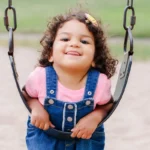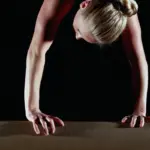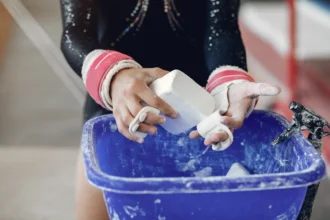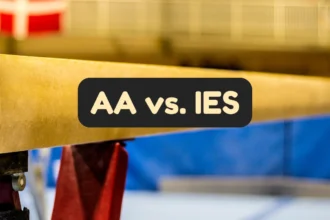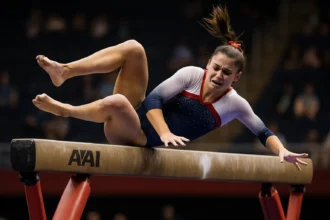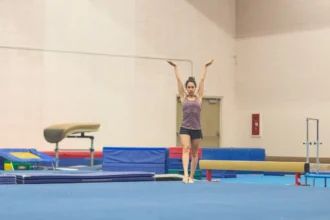Level 3 is where floor routines start to feel more like real performances. Gymnasts build on their basics from Levels 1 and 2, adding more power, sharper movement, and longer sequences.
This routine includes a handstand, a leap pass, a stretch jump to split jump, a bridge kick-over, and even a round-off back handspring at the end. It’s a big milestone.
Starting with First Position and Poses
The routine begins in the middle of the floor on a straight diagonal. The gymnast stands with both feet together, then gently rocks back and opens the heels into first position. The non-dominant foot stays turned out, and the dominant leg crosses over in front.
The dominant arm goes behind the back. The other arm stretches out to the side, and the gymnast looks down at their fingertips. This is the official starting pose.
From there, the gymnast opens the dominant leg out to the side while forming a strong T with their arms. They bend into a plié with the back leg, pull the leg in with arms at the hips, then return to the T shape. This sequence is done sharply to match the beat of the music.
After repeating the T-hips-T movement, the gymnast pulls the feet together, lifts the arms overhead, and points the dominant foot out in front. All the weight should stay on the back foot.
Acro Sequence: Handstand to Forward Roll
From the pointed position, the gymnast steps into a mountain climber, performs a handstand with a brief hold, then immediately rolls forward. After standing up with feet together, they stretch tall, then point the dominant foot forward again and hold a T position with the arms.
They bend into a plié, chasse forward, then step through into another plié, ending in a pointed pose. The back foot should be straight and pointed, and the gymnast finishes with arms down and eyes focused forward.
Turn, Leap, and Fish Pose
With the non-dominant leg in front, the gymnast prepares for a turn. They press through the dominant foot, turning toward the back leg while dropping into a forced arch. Arms lower, palms turn upward, and the gymnast looks over their dominant arm.
They point their non-dominant foot forward to get ready for the leap. The leap pass begins with a plié, then a chasse using the non-dominant leg. The gymnast leaps on the dominant leg, steps through on tiptoes, and finishes in a fish pose—arms crossed at the wrists and body arched slightly.
From there, they step together and prepare for the next section.
Stretch Jump to Split Jump
At this point in the music, there’s a rhythm change. The gymnast rises into a strong pose by bending both ankles into a forced arch and placing two fingers from the dominant hand on the opposite shoulder. They look over their non-dominant arm.
They then go into a stretch jump followed by a split jump. The arms land low and then rise again to finish. The gymnast points the front foot to signal readiness for the next acro skill.
Bridge Kick-Over and Split Series
The next skill sequence includes a mountain climber into a handstand that falls to a bridge. From the bridge, the gymnast kicks over and stands up into a tall finish. This is a dramatic part of the routine.
From standing, they drop back slightly, raise their arms, and act like they’re catching a beach ball. The dominant leg slides forward as they drop into a split. Both hands touch the chest, then they lean sideways over the non-dominant leg. They bring the legs together, roll into a mermaid position, and spin around on their bottom with the dominant leg in front and the other tucked underneath.
Standing and Lock Turn
From the mermaid pose, the gymnast places their hands behind them, presses up, and starts swinging the dominant arm. When their hands are in a straight line, they use that momentum to stand.
They rise into a lock stand and prepare for a half turn. The turn is done with the non-dominant leg lifting into passé while the arms form a clean, rounded shape in front. This is followed by a backward roll to a three-quarter handstand that finishes in a push-up position.
From the push-up, they tuck the knees in, open the arms, and press up into a lock stand. The arms then move to the hips as the gymnast looks over their non-dominant shoulder.
The Big Finish: Round-Off Back Handspring
To begin the final section, the gymnast takes their back foot and steps as far into the corner as they can. Then they open and close their body like a little penguin before launching into a round-off back handspring.
After rebounding, they step the dominant foot forward, lower to the floor with the non-dominant leg bent, lift the hips, and hold a final ending pose of their choice. As long as the bottom is on the heels and knees are down, the ending pose is open for personal expression.



